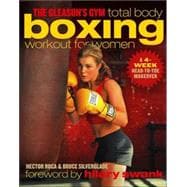PUT SOME PUNCH
* * * * IN THE WAY * * * *
YOU GET INTO SHAPE!
Defined arms; sleek shoulders; flat, tight abs; lean, firm legs -- this is the shape that women want to get fro

PUT SOME PUNCH
* * * * IN THE WAY * * * *
YOU GET INTO SHAPE!
Defined arms; sleek shoulders; flat, tight abs; lean, firm legs -- this is the shape that women want to get fro
| Foreword | |
| Introduction: The History of Gleason's Gym Bruce Silvergrade, owner | |
| Gleason's Total Body Makeover: About the Program | |
| Mental Preparation: Are You Ready? | |
| Live Right | |
| Boxing Basics | |
| Training Basics | |
| Week One: Build Your Foundation | |
| Week Two: Find Your Style and Strength | |
| Week Three: Counterpunch | |
| Week Four: Become a Knockout | |
| The Next Level: Advancing Your Skills in the Gym | |
| Acknowledgments | |
| About the Authors | |
| Table of Contents provided by Publisher. All Rights Reserved. |
The New copy of this book will include any supplemental materials advertised. Please check the title of the book to determine if it should include any access cards, study guides, lab manuals, CDs, etc.
The Used, Rental and eBook copies of this book are not guaranteed to include any supplemental materials. Typically, only the book itself is included. This is true even if the title states it includes any access cards, study guides, lab manuals, CDs, etc.